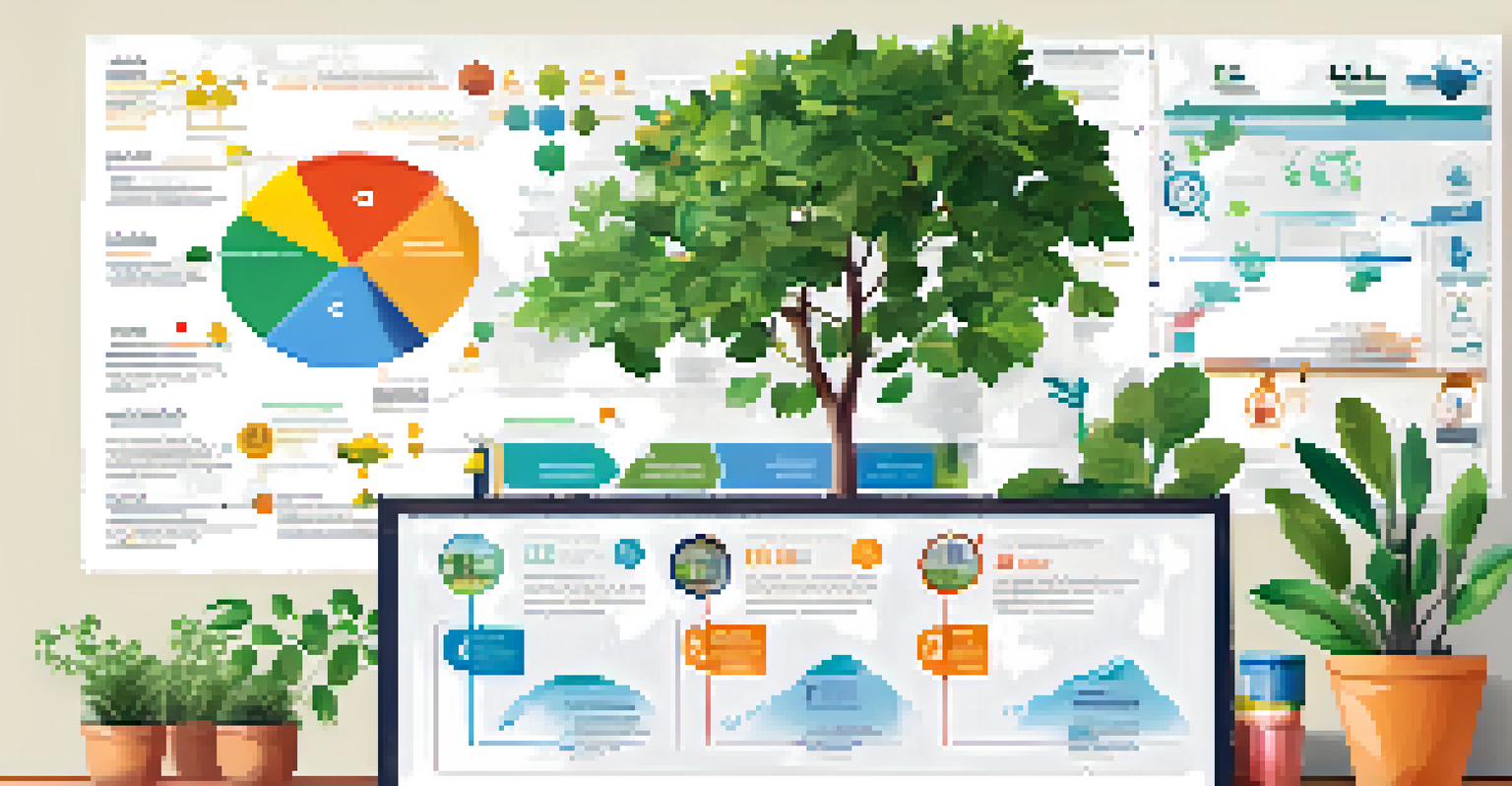Essential Tools for Creating Your Career Goals Visual Map

Understanding the Concept of a Visual Career Map
A visual career map is like a roadmap for your professional journey. It helps you visualize where you want to go and the steps needed to get there. By laying out your goals, skills, and potential paths, you create a clear representation of your aspirations.
Setting goals is the first step in turning the invisible into the visible.
Think of it as a treasure map leading you to your career goals. Instead of wandering aimlessly, you can see the milestones that guide you along the way. This not only keeps you focused but also motivates you to take actionable steps toward achieving your dreams.
Using a visual format makes your goals more tangible and easier to digest. It’s much simpler to track your progress and adjust your route as needed, ensuring that you remain aligned with your career vision.
The Power of Mind Mapping Software
Mind mapping software is an excellent tool for brainstorming and organizing your career goals. It allows you to visually connect different ideas, making it easier to see patterns and relationships. Popular options like MindMeister or XMind can help you create a structured outline of your aspirations.

Imagine starting with your ultimate career goal at the center of the map, then branching out to key skills, experiences, and milestones. This visual representation facilitates a deeper understanding of what you need to achieve. Plus, it’s easy to modify as your goals evolve.
Visual Career Maps Guide Your Path
Creating a visual career map helps you clarify your goals, skills, and the steps necessary to achieve your professional aspirations.
Using colors and images in mind maps can also enhance creativity and engagement. The more interactive and visually appealing your map, the more motivated you’ll be to refer to it regularly and take action toward your career objectives.
Harnessing Project Management Tools for Goal Tracking
Project management tools like Trello or Asana can be invaluable for tracking your career goals. These platforms allow you to break down your objectives into actionable tasks, assigning deadlines and priorities. This structured approach keeps you organized and accountable.
A goal without a plan is just a wish.
Think of it as having a personal assistant guiding you through your career journey. You can create boards or lists that represent different stages of your career map, helping you visualize progress. Completing tasks gives you a sense of achievement and motivates you to move forward.
Additionally, these tools often include collaboration features, allowing you to share your goals with mentors or peers. This support network can provide valuable feedback and encouragement, enhancing your path to success.
Utilizing Visualization Apps for Goal Clarity
Visualization apps like Canva or Piktochart can help you create eye-catching representations of your career goals. With user-friendly interfaces, you can design infographics or charts that summarize your aspirations in a visually appealing way. This kind of clarity enhances your focus.
Imagine creating a vibrant infographic that outlines your skills, experiences, and future goals. This not only serves as a personal reminder but can also be shared with others to articulate your career vision. Having a visual tool can make your goals feel more real and achievable.
SMART Goals Enhance Success
Setting SMART goals ensures your career objectives are specific, measurable, achievable, relevant, and time-bound, increasing your chances of success.
Moreover, customizing your visuals with personal touches can make the process enjoyable. Whether you prefer bold colors or minimalist designs, the act of creating your own visual map can be a powerful motivational experience.
Incorporating Journaling for Self-Reflection
Journaling is a fantastic tool for self-reflection and can complement your visual career map. Writing down your thoughts and feelings about your goals helps clarify your motivations and potential obstacles. Regular reflection allows you to adapt your map based on your experiences.
Think of journaling as a way to have a candid conversation with yourself. By documenting your progress and challenges, you can identify patterns that may need addressing. This ongoing dialogue can lead to deeper insights about your career aspirations.
Additionally, journaling can serve as a space to celebrate small victories. Recording these moments of progress reinforces your commitment and encourages you to keep pushing forward toward your larger career goals.
Engaging with Online Career Planning Platforms
Online career planning platforms like CareerBuilder or LinkedIn Learning offer tools to help you map out your career goals. These resources provide career assessments, skill development courses, and networking opportunities tailored to your aspirations. Engaging with these platforms can enhance your visual map significantly.
Imagine discovering a new skill you need for your dream job through a course suggestion on LinkedIn Learning. This newfound knowledge can directly feed into your visual map, helping you refine your path. Plus, you can connect with professionals in your desired field for guidance and mentorship.
Regular Updates Keep Your Map Relevant
Regularly updating your visual career map ensures it reflects your evolving aspirations and experiences, keeping your career journey aligned with your current self.
By regularly interacting with these platforms, you can stay updated on industry trends and best practices. This knowledge can help you adjust your career map as needed, ensuring you remain relevant and prepared for future opportunities.
Setting SMART Goals for Effective Planning
When creating your career goals visual map, using the SMART criteria is essential. SMART stands for Specific, Measurable, Achievable, Relevant, and Time-bound. This framework ensures that your goals are clear and attainable, increasing your chances of success.
For example, instead of saying, 'I want to improve my skills,' a SMART goal would be, 'I will complete two online courses in project management by the end of this quarter.' This specificity clarifies your objective and gives you a timeline, making it easier to track progress.

By incorporating SMART goals into your visual map, you set yourself up for success. Each goal becomes a stepping stone on your journey, providing a clear direction and measurable outcomes that keep you motivated and accountable.
Regularly Updating Your Visual Career Map
Your visual career map isn't a one-time project; it's a living document that should evolve as you grow. Regular updates are vital to reflect your changing aspirations, skills, and experiences. By revisiting your map, you can adjust your goals and strategies as needed.
Consider setting aside time every few months to review your map. This could involve assessing what you've achieved, identifying new goals, or even pivoting if your interests have shifted. An updated map keeps your career journey relevant and aligned with your current self.
Moreover, sharing your updated map with mentors or peers can provide valuable insights. They may offer different perspectives or suggestions that can enhance your career planning. This collaborative approach can further enrich your visual map, making it a more powerful tool in your professional journey.